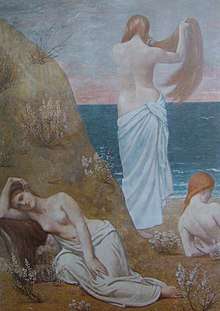Gymnopédies
The Gymnopédies (French pronunciation: [ʒim.nɔ.pe.di]), or Trois Gymnopédies, are three piano compositions written by French composer and pianist Erik Satie. The first and third were published in 1888 and the second in 1895.
History

The work's unusual title comes from the French form of gymnopaedia, the ancient Greek word for an annual festival where young men danced naked – or perhaps simply unarmed. The source of the title has been a subject of debate. Satie and his friend Alexis Roland-Manuel maintained that he adopted it after reading Gustave Flaubert's novel Salammbô, while others see a poem by J. P. Contamine de Latour as the source of Satie's inspiration,[1][2] since the first Gymnopédie was published in the magazine La Musique des familles in the summer of 1888 together with an excerpt of Latour's poem Les Antiques, where the term appears.[1][3]
Oblique et coupant l'ombre un torrent éclatant |
Slanting and shadow-cutting a bursting stream |
However, it remains uncertain whether the poem was composed before the music. Satie may have picked up the term from a dictionary such as Dominique Mondo's Dictionnaire de Musique, where gymnopédie is defined as a "nude dance, accompanied by song, which youthful Spartan maidens danced on specific occasions", following a similar definition from Jean-Jacques Rousseau's Dictionnaire de Musique.[1]
Later in 1888, the third Gymnopédie was published. The second Gymnopédie did not appear until seven years later, and its impending publication was announced in several editions of the Chat Noir and Auberge du Clou magazines.
Pierre Puvis de Chavannes' symbolist paintings may have been an inspiration for the atmosphere Satie wanted to evoke with his Gymnopédies.[4]
Music
These short, atmospheric pieces are written in 3
4 time, with each sharing a common theme and structure.
- Lent et douloureux (D major / D minor)
- Lent et triste (C major)
- Lent et grave (A minor)
The melodies of the pieces use deliberate, but mild, dissonances against the harmony, producing a piquant, melancholy effect that matches the performance instructions, which are to play each piece "painfully" (douloureux), "sadly" (triste), or "gravely" (grave). The first few bars of Gymnopédie No. 1 (shown below) consist of an alternating progression of two major seventh chords, the first on the subdominant, G, and the second on the tonic, D.
Reception
By the end of 1896, Satie's popularity and financial situation were ebbing. Claude Debussy, whose popularity was rising at the time, helped draw public attention to the work of his friend. Debussy expressed his belief that the second Gymnopédie did not lend itself to orchestration. (Orchestrations of this Gymnopédie were only realised many decades later, by other composers, and not frequently performed.) Thus, in February 1897, Debussy orchestrated the third and first only, reversing the numbering: Satie's first became Debussy's third, and vice versa. The score was then published in 1898.
Legacy
From the second half of the 20th century on, the Gymnopédies were often erroneously described as part of Satie's body of furniture music, perhaps because of John Cage's interpretation of them.[5] Collectively, the Gymnopédies are regarded as an important precursor to modern ambient music.[6]
The first and second Gymnopédies were arranged by Dick Halligan for the group Blood, Sweat & Tears under the title "Variations on a Theme by Erik Satie" on the group's eponymous album, released in 1968. The recording received a Grammy Award the following year for Best Contemporary Instrumental Performance.[7] In 1979, the English/Australian musical group Sky performed Gymnopédie No. 1 on their self-titled debut album. The track also appeared on Sky's 1984 compilation album Masterpieces, The Very Best of Sky. In 1980, Gary Numan produced a track called "Trois Gymnopedies (First Movement)", which appeared on the B-side of the single "We Are Glass".[8] In 1999 the chord sequence was used in the Sunship remix of the song "Flowers" by girl band Sweet Female Attitude. All three pieces were arranged with percussion by the UK electronic duo Isan in 2006, in their signature analogue sound. Gymnopédies have been heard in numerous movies and television shows. Examples include Louis Malle's My Dinner With Andre, the French thriller Diva, the documentary Man on Wire,[9] Wes Anderson's The Royal Tenenbaums,[10] and Woody Allen's Another Woman,[11] all of which use Gymnopédie No. 1 in their soundtracks. In 2007 Wilhelm Kaiser-Lindemann arranged the first and the third Gymnopédie for The 12 Cellists of the Berlin Philharmonic.[12] Jack DeJohnette included a tribute to Gymnopédies in his 2016 album Return.[13]
References
- Mary E. Davis (2007). Erik Satie. Reaktion Books. p. 31.
- Robert Orledge, Satie the Composer, Cambridge: Cambridge University Press, 1990, p. 207, ISBN 978-0-52135-037-2
- Erik Satie, Ornella Volta (2000), Correspondance presque complète, Paris: Fayard/Imec, p. 936, ISBN 978-2-213-60674-3
- Steven Moore Whiting. Satie the Bohemian: From Cabaret to Concert Hall. Clarendon Press, 1999. ISBN 0191584525, p. 129
- Cage's Place in the Reception of Satie by Matthew Shlomowitz (1999) Archived 2005-10-26 at the Wayback Machine on Niclas Fogwall's Erik Satie website.
- Mark Prendergast, The Ambient Century: From Mahler to Moby – The Evolution of Sound in the Electronic Age, London: Bloomsbury, 2000, p. 6 ISBN 0-7475-5732-2
- "12th Annual Grammy Awards". Grammy Award.
- "Gary Numan - We Are Glass". Discogs. Retrieved 2019-10-21.
- "Man on Wire Soundtracks". IMDb. Retrieved 18 March 2015.
- "The Royal Tenenbaums Soundtracks". IMDb. Retrieved 20 January 2017.
- Another Woman (1988) - Satie's "Gymnopedie No. 1" (aka "Marion's theme"). YouTube. June 17, 2011.
- "Fleur de Paris". Prestoclassical.co.uk. EMI Classics.
- "Jack DeJohnette - Return". Newvelle Records. Retrieved 21 February 2019.
External links
| Wikimedia Commons has media related to Gymnopédies. |
- Gymnopédies: Scores at the International Music Score Library Project (IMSLP)
- Free sheet music of 3 Gymnopédies from Cantorion.org
- Public Domain Sheet Music of the Gymnopédies at the Mutopia Project